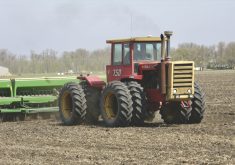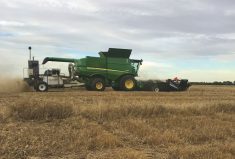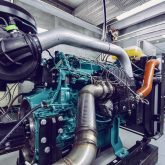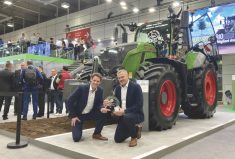A friend has been keeping me posted by email about her trouble finding a full-time employee for the family farm in Saskatchewan. If it didn’t represent such a serious problem for the operation, the details would actually be pretty funny. A few — how do I say it? — less-than-adequate applicants are all her efforts have netted so far.
Two days before her last email, I was in the small garage above, tucked behind a house in Regina, and I was looking at what could become the long-term solution to her HR problem. It was a compact tractor matched to a special two-row corn planter, with both of them wrapped in a network of electrical cables and computers.
Read Also

What to consider when setting up farm-related business ventures
Things to consider before launching a farm-adjacent side business.
It made me think of Hewlett and Packard inventing the computer era in their own garage, because this is no average tractor and planter. Instead, they’re the foundation for a general-purpose farm robot that will be entered in the upcoming AgBot Challenge to be held in Illinois this May. The winner of that event will need to prove their machine can work entirely on its own.
In this case, that means the robot must be capable of loading its own seed and planting a series of corn rows in a field, all without human intervention.
The small group of industrial systems engineering students from the University of Regina who were busy working on that little tractor and planter in their urban workshop were urged by their professor to enter the competition as their final-year class project.
“The driving force for students has been the excitement,” says Mehran Mehrandezh, associate professor in industrial systems engineering at the U of R. “If they see something exciting, they go for it. We can make this very exciting and at the same time very useful.”

Of course, the US$50,000 first prize in the AgBot Challenge helps add to that excitement.
Autonomous systems have been appearing with increasing frequency at farm shows lately. And as I stood among the budding engineers in that Regina garage, joined by their mentor and a farmer who has actually put robotics to work on his farm, it seemed unstoppable; general-purpose robots in agriculture are about to hit a critical mass.
Major manufacturers all quietly acknowledge they could put an automated tractor on the market tomorrow, and even though they aren’t yet willing to do so, efforts like those of these students are proof the future is getting impatient.
The widespread adoption of farm robotic systems may actually be poised to mimic the initial phase of the home computer. In the 1970s, the first personal computers came as DIY projects made up of a box full of parts that needed to be assembled on the workbench. The same is likely to be true for the first wave of on-farm robotic control systems.
But unlike those home computer kits, which didn’t really have a clearly defined purpose in the early days, on-farm robotics may fill an immediate need for manpower and efficiency.
“Will there be (robotic control) kits available?” Mehrandezh wonders rhetorically. He also sees a parallel to those early days of the personal computer.
“Right now it’s a community of hackers that are buying these cheap components and working in garages,” chimes in Sam Dietrich, one of the students on the team. “There’s nothing on the market yet, which is kind of surprising, I think.”
“A lot of people are able to get these components, use open-source libraries and do stuff like this,” adds Joshua Friedrick, another team member.
Maybe, but putting together an entry with all the sophistication to make it a contender in the upcoming AgBot Challenge required getting some sponsorships. In this case, a local Kubota dealership provided a 26-horsepower tractor for them to modify. And Saskatchewan-based Seed Hawk, an implement manufacturer, custom built a two-row planter for it to pull.
“Technology and robotics are all becoming very mainstream in agriculture,” says Edward Lambert, vice-president of R&D at Seed Hawk. “It will get to a tipping point where the next phase is automation. A lot of our customers are excited about new technology and what we’ve come up with. They can see there’s going to be another leap in the future as well.”

And Professor Mehrandezh wants his team to ensure this leap is a big one.
“I told these guys, let’s not just move forward this much,” Mehrandezh recalls, holding his fingers an inch or two apart. “Let’s have a quantum leap. Let’s go to swarm farming so we’ll be ahead of everybody else. Taking this to the next level of swarm farming is not that difficult.”
The swarm idea refers to having a group — or swarm — of smaller machines working together in a field.
“If we can make this navigate off a GPS signal, it’s just an extra 20 lines of code to make it follow another tractor,” agrees Friedrick. “It’s very easy for us to just expand it into a lot of different areas.”
That’s an idea that Lambert thinks has merit.
“I don’t like the word swarm, especially in agriculture,” he says with a laugh. “But it’s something a lot of companies are working on, to get multiple machines in the field working together. I think one of the trends going forward is faster machines and smaller machines, because not everybody can handle a 100-foot-wide implement. I think we’re probably getting to the limit of how big tools and tractors will be.”
He isn’t alone in that thinking. Another industry insider I spoke to recently confided that he believed the trend to bigger implements is about to reverse itself, in large part due to the potential offered by automation.
“The next phase going forward, it may be five years or 10, I don’t know the time frame just yet, but autonomous vehicles will be something farmers will go for,” says Lambert. “I think it can be produced in a very economical way and provide value to the farmer. It’s not too far away. I can see it happening within my career.”
For Manitoba farmer Matt Reimer, a robotic tractor he can put to work is no longer a pie-in-the-sky idea. He has already created a robotic control system to use on a high-horsepower tractor on his farm.
“There are definitely some people who think what I’m doing is nuts,” he says, but many others have expressed genuine interest.
The quality and durability of a wide variety of the electronic components and sensors necessary to create robotic systems has grown exponentially in recent years, while their cost has fallen at an almost equal rate.
The U of R team’s little tractor takes advantage of that. Relatively inexpensive components — that are becoming progressively cheaper as time goes on — are what make up the bulk of the team’s autonomous system. To keep things simple, a computer controls off-the-shelf actuators that manipulate the manual controls on the tractor just as a driver would.
“Our main goal right now is to interface all our components with the controls that are already there,” says Friedrick. “What we’re focusing on is the software and control system. Most of our time is spent programming.”
Reimer took the same approach to automating his tractor. Although he had no formal training in computer programming, he was able to find an online course to get some basic skills allowing him to write the software code he needed, borrowing much from free, open-source programs available online.
The U of R students will be busy over the next two months getting their robot ready for the upcoming challenge. Lambert thinks the work they’ll do will help the industry overall, even if they don’t end up creating a market-ready system.
“As manufacturers, we don’t always have the opportunity to take something right from the grassroots,” he says. “To get the university to help us with that is really a benefit.”
The team also thinks of the tractor as the start of a legacy project that future students can build on and develop further.
“We’ve actually started a club at the U of R, an agricultural robotics club,” says Dietrich. “We kind of see it as being a lasting piece at the University of Regina.”
Mehrandezh thinks the team’s efforts could be a significant stake in the ground, putting the U of R firmly on the robotics engineering map.
“I want to make this like a centre of excellence, headquartered at the University of Regina,” he says.
For Reimer and his farming operation, the benefits of robotics are already here for the taking. Having his driverless tractor pull a grain cart during harvest last fall freed up manpower to tackle other jobs that needed to get done.
Says Reimer, “I had the best fall I’ve ever had in terms of getting things ready for this coming spring (with a robotic tractor in the field). We’re not going back.”
















